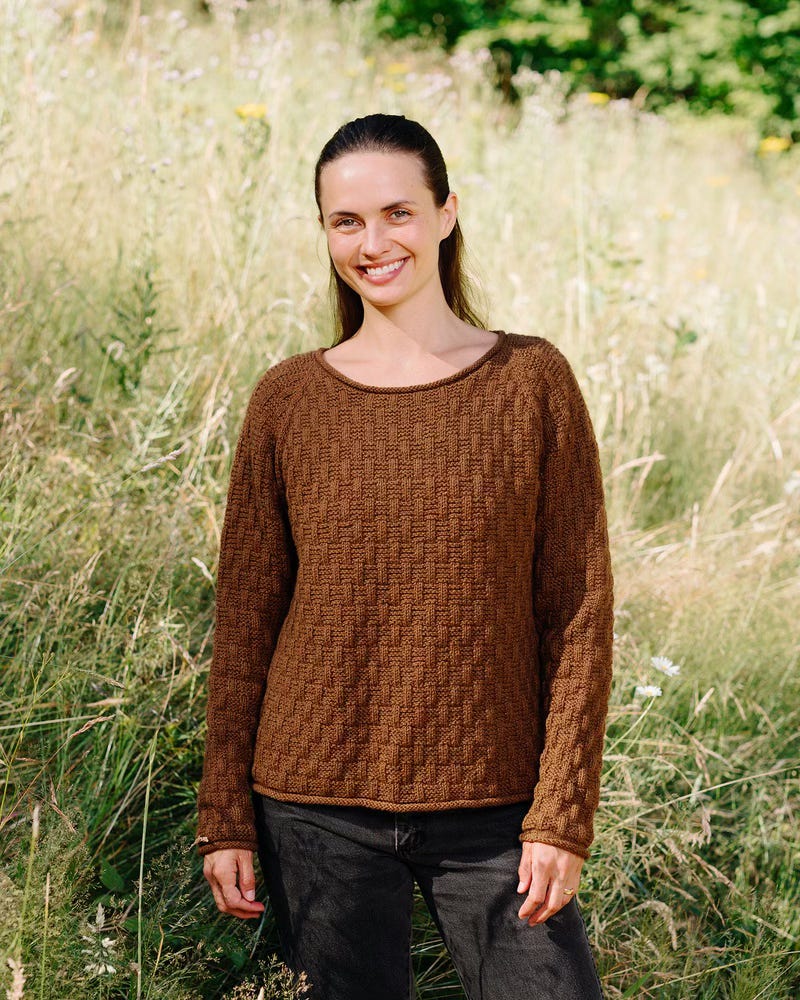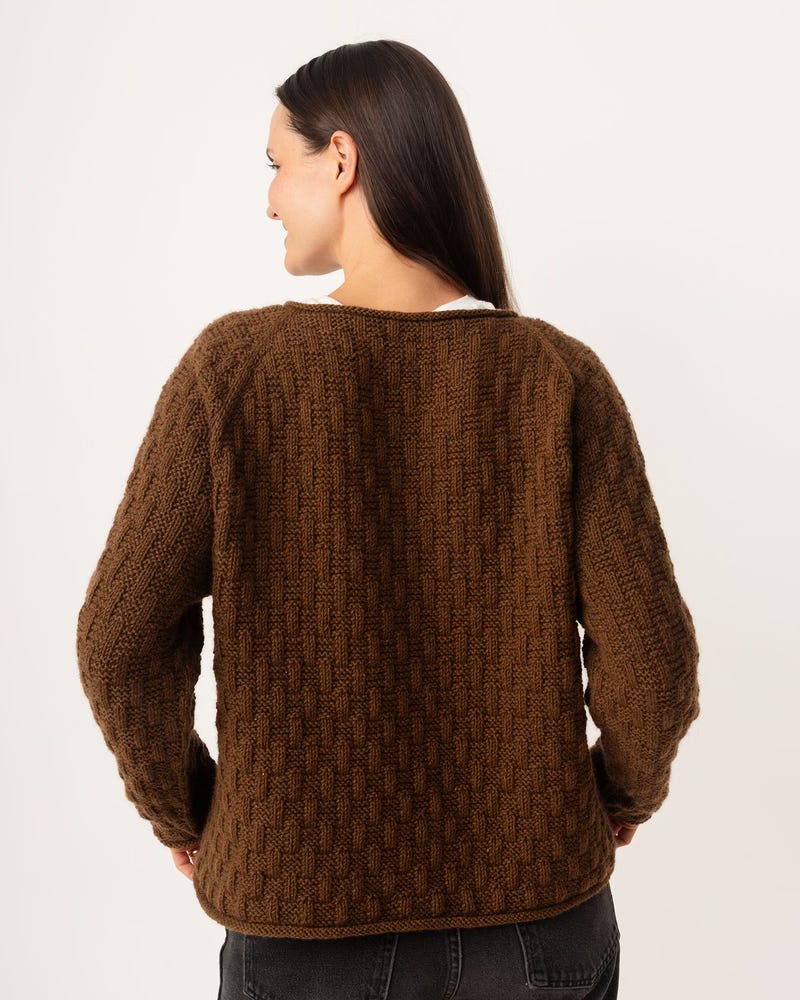A new project I designed for Knit Picks has just been released, and I'm excited to share it with you! Meet the Fireside Pullover.
This sweater was knit with Woolen Cotton, which I reviewed in a Yarn Face-Off back in March. When this yarn was first introduced, it came in a limited palette of earthy, autumnal colors. I'm delighted to see that Knit Picks has expanded the line to 21 colors, making room for some zippy brights.
This pattern is part of an eBook collection called Outdoor Adventure: Knits for Exploring. The collection includes patterns for two hoodies, a cardigan, a poncho, a hat, a pair of mittens, and two pairs of socks, in addition to my pullover.
FYI: These links are not affiliate links. I was paid by Knit Picks to create this design, but I will receive no additional compensation or commission if you make a purchase using these links.
The theme for the collection, as outlined in the call for submissions, was Fall, outdoors, camping, and hiking. I wanted to produce a simple, gender-neutral pullover you could wear like a sweatshirt. The Fireside Pullover is knit seamlessly from the top down, with raglan shaping, a pleasing basketweave texture, and casual rolled edges.

You may notice (I sure did) this sweater looks oversized on the model. The recommended fit for this design is 2–6" of positive ease. The sample sweater is size 43½", and the model has a 34" bust. That means the sweater is shown with 9½" of positive ease. No wonder it looks like she borrowed it from her boyfriend!

What is Ease?
Ease is the difference between the finished measurements of the garment and the measurements of the body the garment covers. Positive ease means the garment is larger than the body. Negative ease means the garment is smaller than the body.
Choosing Which Size to Make
One of the wonderful things about knitting your own sweaters is you can choose exactly how you want them to fit. I like to wear my sweaters with 2–4" of positive ease. For me, that feels just right: not so snug that it clings to every contour of my body, and not so loose that it looks like I'm hiding in a tent. My full bust measurement is 49", and I aim for about a 52" body circumference in a pullover for myself.
You may prefer the snug "sweater girl" fit popular in the 1950's. In that case, you're going to aim for negative ease. You might like a looser, oversized fit. In that case, you'll want to aim for a generous amount of positive ease.
To help determine the ease you like best, start with a sweater that fits you just right. If you don't have one already in your collection, take a tape measure with you to the mall and try on sweaters in a variety of stores. Lay the sweater flat, then measure the width across the body just below the underarms. Double that measurement to get the finished body circumference of the sweater. Compare this to your full bust measurement (not your bra size—the measurement around your body at the fullest part of your bust) to determine your desired amount of ease.
Let's say your example sweater measures 22" across, for a 44" finished circumference, and your full bust measurement is 39". That sweater fits you with 5" of positive ease.
Now look at your sweater pattern. Find the finished body circumference measurements. Ignore any size designations such as S/M/L. Ignore any measurements labeled "to fit". You are looking for the finished garment measurements.
Add your desired ease to your full bust measurement and choose the pattern size that comes closest to that sum. What if you are right in the middle between sizes? Round down if you're using fingering, sport, or DK weight yarn. Round up for worsted weight or heavier. The thickness of the fabric made using heavier yarns takes up some of the space between the garment and your body. You'll probably be happier with a little more ease in a chunkier sweater.
Why Was This Sweater So Big on the Model?
I don't know, but I can make an educated guess. When samples for photography are made, sizes are chosen with a particular size model in mind. A model might not yet have been booked for the photoshoot, but the editors know what size they will be looking for.
The garments in this collection were knit in sizes ranging from 40–43½". I suspect the initial plan was to use a model with a 36–38" bust. Perhaps they booked a larger model, she cancelled at the last minute, and the only models available on short notice were much smaller. The best laid plans, and all that…
Now that you know how to choose the right size for YOU, you won't be misled by the fit shown in photos. You can use your own measurements and your preferred ease to create a sweater with the fit you love!
That's it for today. I came home from my trip to Maker Festivals last week with a case of Covid, so I'm conserving my energy.
One last thought
The problem with holding a grudge is that it makes your hands too full to do anything useful. – Seth Godin
I love Seth Godin. If you don’t know his daily email newsletter, check it out at the link above. Seth sends daily nuggets of wisdom on how to show up and make a difference in the world.
As always, thank you for choosing to spend some time reading what I write. I appreciate you!
Continue the conversation: Do you know how much ease you prefer in your sweaters? Does it vary depending on the style? Tell me about it in the comments!







I love the sweater, and I love it as oversized on the model. I like a fair amount of ease in my sweaters, although my favorite sweater (which I bought on sale from Whole Earth back in the late 80s) has only a couple inches for ease … now. It definitely had more ease when my body was a bit slimmer 40 years ago 😆 Thank you for your wonderful explanation of ease and how to calculate it. I hope you feel better soon!
Sandi, wishing you all better soon. I highly recommend Instacart for bringing anything you might need to your door.
Love your words on ease and The Pattern! Glad you explained about the oversized sweater on the model. As I have narrow shoulders, and I am also short waisted with broad hips (think frogs' body 😂) I had to learn early how to choose the correct size and then how to correct for my needs. I find it is worth it! Having a garment fit my body shape does improve my appearance. One of the things I often do is shorten the armholes and sleeve caps. I just don't need or want all that extra fabric at the underarm or biceps. Sometimes, depending on the style, I shorten the width of shoulder seams. I like keeping a garment in a similar style that fits me nearby as I knit. It is an easy way to check on the size and shape that I am aiming for.